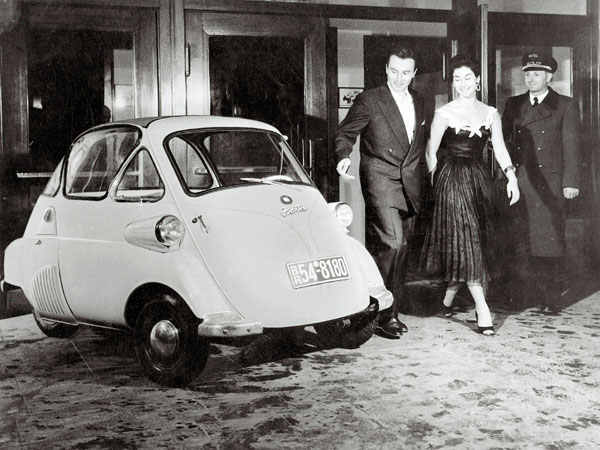
On first sighting most BMW owners would probably never believe that a car of this design carried the famous logo of this marque. Perhaps on reflection they may realise that BMW is also famous for its range of motorcycles and hence could understand that such a vehicle could have come from Bayerische Motoren Werke of Germany.
Originally designed in Italy where the concept found little interest it later became one of the most successful mini-cars in postwar Germany. It was powered by a 247cc BMW motorcycle engine and first built in 1955. In 1957 a facelifted version was introduced which featured a 297cc engine variant. Domestic models had four wheels but some models built for export were designed with only a single rear wheel to take advantage of tax structures in certain countries that favoured three-wheel vehicles with lower tax rates.
The chassis and engine of the Isetta were simplicity itself, with the motorcycle-derived single-cylinder engine and entire drivetrain packed in ahead of and between the narrowly spaced rear wheels. It was air cooled, fitted with drum brakes, weighed 360 kg and had a maximum speed of 85 km/h. Over 150,000 units were produced during the period 1955 to 1962.
The front opening door, taking the steering wheel and instrument panel with it, was common to all Isetta variations. It was a rear-engined two-seater with simple sliding-panel side windows and a sunroof. The headlights were mounted on either side of the driver’s compartment back from the opening front door rather like the peripheral lights of a diving bell.
Occupant safety was obviously not on the designers’ agenda. The interior door handle was opposite the driver and in a front-end accident the driver would likely be pinioned by the flimsy steering wheel, and would be unable to reach the door latch. Beyond that, any serious front end collision would very likely have resulted in the deaths of driver and passenger, as there was no substantial structure to prevent the Isetta from crumpling front to rear like a piece of paper.
Should the occupants have survived a head-on, there was no way short of smashing the windows to escape, as the only normal egress was the (probably) jammed front door. Also, in those days before standardised seatbelts, there was nothing in the Isetta to keep the passenger from hurtling through the front windshield.
Had the Isetta been a good-handling little machine, one could have driven defensively, but its wide-front-narrow-back track widths were best suited to go in a straight line. Incidentally, the back wheels also steered the car, making this strange little car truly mechanically backward.